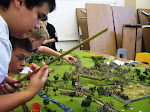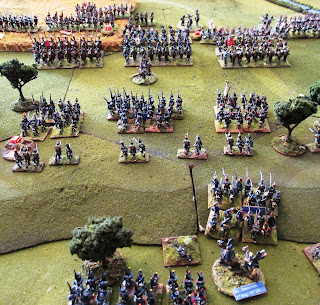I had a great time today with three of my most accomplished student. The four of us gathered together at 9:00 for a Regimental Fire and Fury game based on the Battle of Chickamauga. Two Confederate divisions squared off against two Union ones. Brian and I commanded the rebels; James and Chris the Yankees.
I had envisioned the Union side to fight a more defensive battle, but was pleasantly surprised to see them aggressively move out on their left flank to attack. This was quite historical actually, and made our game very interesting. I commanded the Confederate left and moved out just as aggressively, hoping to turn the Union flank before they could send reinforcements from their left.
 |
| Turn 1: Cheatham's division moves out. |
 |
| Turn 1: Willich's Yanks attack the rebel right |
 |
| Turn 2: The Confederate brigades move rather quickly through the thick forests to get at the Union right. |
 |
| Turn 2: The Union also strikes down the Brotherton Road. |
By turn three the battle was in full swing. Due to the thick forests, artillery was extremely limited and the effects of musketry were reduced. Nevertheless, casualties began to mount on both sides across the table.
 |
| Turn 3: first shots fired. |
 |
| Turn 4: Willich makes gains on the left |
 |
| Turn 4: This became the "bloody angle" of our battle. Many Yankees fell here. |
 |
| Turn 4: Action in the center |
 |
| Turn 4: Cheatham is ready to attack |
 |
| Turn 4: The rebs counter-attack. |
On turn five Cheatham unleashed his assault on Grose's over-stretched brigade. Grose's men gave ground grudgingly. This would not be the lightening victory the Confederate generals had anticipated.
 |
| Turn 5: Cheatham's brigades scramble through the rough terrain and pile in against a stubborn defense. |
 |
| Turn 5: The Yankees give ground, but despite being heavily outnumbered, manage to keep the gray flood at bay. |
 |
| Turn 5: Hazen's men fight heroically to hold the critical high ground in the center. |
By turn seven the Union commanders were able to shift a brigade from their left to their right. But would it be enough and in time to save the day?
 |
| Turn 7: Reinforcements arrive. |
One of the fun things about RFF is when a "0", or 10, is rolled on the 10 sided die. This forces a check to see if any general within 4" becomes a casualty. A second toss of 1-7 isn't a real problem as it translates into a minor wound at worst. On an 8, 9, or 10 however, the commander is lost for the game. On turn 8 the Confederates lost Brigadier General P. Smith to a mortal wound. On turn 9, General Grose was felled by a bullet as well. This came at the very worst time as his brigade was already at a breaking point.
 |
| Turn 9: Cheatham secures the hill. |
 |
| Turn 9: The Union attack down the Brotherton Road is stalled. |
 |
| Turn 9: The fighting in the center has been particularly desperate. |
We called the game after turn 11. The Union right had been smashed. Gains had been made in the attack on the rebel right, but any support for Willich had been diverted to the other end of the battlefield and Strahl's fresh brigade of Confederate infantry was making its way to drive him back. In terms of casualties, two Union men fell for every Confederate.
This was a very fun battle with some terrific young men. Their grasp of the rules made the time very enjoyable for all of us. I look forward to future engagements with this up and coming gamers.

















































